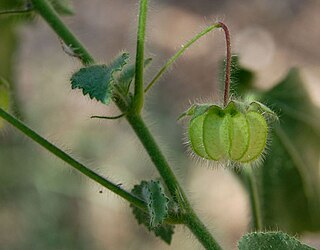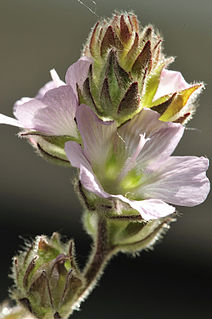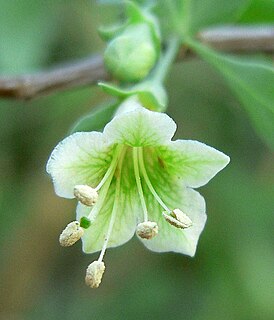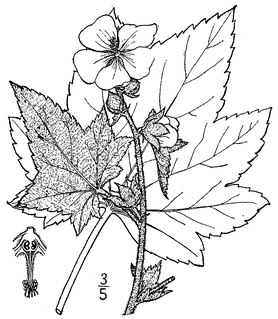
Abutilon is a large genus of flowering plants in the mallow family, Malvaceae. It is distributed throughout the tropics and subtropics of the Americas, Africa, Asia, and Australia. General common names include Indian mallow and velvetleaf; ornamental varieties may be known as room maple, parlor maple, or flowering maple. The genus name is an 18th-century New Latin word that came from the Arabic ’abū-ṭīlūn, the name given by Avicenna to this or a similar genus.

Abutilon menziesii, known as Koʻoloaʻula in Hawaiian, is an endangered species of flowering shrub in the mallow family, Malvaceae, that is endemic to Hawaii. It is a sprawling shrub that can reach up to 10 feet in height. The leaves, which range from an inch in width to about five inches, vary in their shapes. They have a velvety feel to them. The small hibiscus-shaped flowers generally hang downward. Though charming up close, the flowers can be hidden by the much larger leaves and not often visible at a distance. Although the Hawaiian name ʻula refers to the more commonly seen red color, koʻoloa ʻula flowers are known in a range of colors: pink, pink and white, pale red, maroon, deep purplish-red (wine), salmon, and blond or butter. The center or staminal column is yellowish.

Abutilon theophrasti is an annual plant in the family Malvaceae, native to southern Asia. Its specific epithet theophrasti commemorates the ancient Greek botanist-philosopher Theophrastus. Abutilon theophrasti is the type species of the genus Abutilon.

Fuchsia excorticata, commonly known as tree fuchsia, New Zealand fuchsia and by its Māori name kōtukutuku, is a New Zealand native tree belonging to the family Onagraceae. It is commonly found throughout New Zealand and as far south as the Auckland Islands. It grows from sea level up to about 1,000 m (3,300 ft), particularly alongside creeks and rivers. It is easily recognised in its native environment by the characteristic appearance of its bark, which peels spontaneously, hanging in red papery strips to show a pale bark underneath. Its scientific name, excorticata, reflects this distinctive property.

Parkinsonia microphylla, the yellow paloverde, foothill paloverde or little-leaved palo verde; syn. Cercidium microphyllum), is a species of palo verde.

Ceanothus integerrimus, known by the common name deer brush, is a species of woody shrub in the family Rhamnaceae, native to the western United States in Arizona, New Mexico, California, Oregon, and Washington. It grows in montane chaparral and woodlands regions, in hardwood forests, and in fir, spruce, and Ponderosa pine plant communities, being most abundant in the California chaparral and woodlands and Sierra Nevada.

Abutilon palmeri, known as Palmer's abutilon, superstition mallow, and Palmer's Indian mallow, is a species of flowering plant native the Southwestern United States and northwestern Mexico.

Bursera microphylla, known by the common name elephant tree in English or 'torote' in Spanish, is a tree in genus Bursera. It grows into a distinctive sculptural form, with a thickened, water-storing or caudiciform trunk. It is found in the southwestern United States and northwestern Mexico.

Abutilon parvulum is a species of flowering plant in the mallow family known by the common names dwarf Indian mallow and dwarf abutilon.

Astragalus brauntonii is a rare species of milkvetch known by the common name Braunton's milkvetch. It is endemic to California, where it is known from fewer than 20 extant occurrences in the hills and mountains surrounding the Los Angeles Basin in Southern California. This is a federally listed endangered species in the United States.

Chaenactis carphoclinia is a species of flowering plant in the daisy family known by the common name pebble pincushion. It is native to the southwestern United States and northwestern Mexico, where it grows in rocky and gravelly habitat, such as the California deserts. The species is found in southern California, Nevada, Utah, Arizona, southwestern New Mexico, Baja California, Sonora.

Herissantia crispa is a species of flowering plant in the mallow family known by the common names bladdermallow and curly abutilon. It is native to the tropical Americas but it can be found throughout the tropical and warmer temperate world as an introduced species and sometimes a weed. This is a perennial or sometimes annual herb growing up to about 1.5 meters in maximum stem length, usually taking a trailing or creeping form. It is coated in whitish hairs. The oval or heart-shaped leaves are up to 7 centimeters long with rippled edges. The inflorescence is a solitary flower emerging from a leaf axil, borne on a long-haired pedicel which is half erect and then jointed downward. The flower has five pale yellow oval petals each up to a centimeter long. The fruit is a lantern-like inflated sphere ribbed into segments. It is up to 2 centimeters wide, coated in long hairs, and dehiscent, each segment containing 2 or 3 black kidney-shaped seeds.

Sidalcea hickmanii is a species of flowering plant in the mallow family known generally by the common name chaparral checkerbloom.
Iliamna corei is a rare species of flowering plant in the mallow family known by the common name Peters Mountain mallow. It is endemic to Virginia in the United States, where it is known only from Peters Mountain in Giles County. A single occurrence remains. This is a federally listed endangered species. It is considered "one of the rarest native plants in the United States."

Amoreuxia gonzalezii is a rare species of flowering plant in the Bixaceae known by the common names Santa Rita mountain yellowshow, Santa Rita throwup weed, saiya and temaqui. It is native to Sonora in Mexico, its distribution extending just above the border into Arizona in the United States, where it occurs in the Santa Rita Mountains of Pima and Santa Cruz Counties. It has also been found in the States of Sinaloa and Jalisco to the south.

Lycium pallidum is a species of flowering plant in the nightshade family known by the common names pale wolfberry and pale desert-thorn. It is native to northern Mexico and the southwestern United States. In Mexico it can be found in Sonora, Chihuahua, Zacatecas, and San Luis Potosi. In the United States it occurs from California to Texas and as far north as Utah and Colorado.

Abutilon fruticosum is a widespread species of flowering plant in the mallow family known by the common names Texas Indian mallow, pelotazo, and sweet Indian mallow. It is native to Africa, southern and southwestern Asia, northern Mexico, and the south-central United States.

Malva pusilla, also known as Malva rotundifolia, the low mallow, small mallow, or the round-leaved mallow, is an annual and biennial herb species of the Mallow genus Malva in the family of Malvaceae. Malva is a genus that consists of about 30 species of plants. This genus consists of plants named mallows. Mallows grow in many regions, including temperate, subtropical, and tropical areas.

Iliamna remota, commonly known as the Kankakee mallow, is an endangered species of flowering plant in the mallow family. It is endemic to a single location, the 700-metre-long (2,300 ft) Langham Island in Kankakee River State Park, in the US state of Illinois.

Acanthoscyphus is a monotypic genus in the family Polygonaceae that contains the single species Acanthoscyphus parishii, which is sometimes called Parish's oxytheca. This species is native and endemic to southern California.




















